Five
PROGRAMS
The academy mission is to graduate young men and women well-grounded in seamanship, science, and the humanities. To do this requires a rigorous schedule of courses and activities. The dean of academics, Kurt J. Colella, PhD, PE, states:
The US Coast Guard Academy is a place that offers a four-year experience filled with exciting challenges that foster the intellectual, physical, and professional growth of our future Coast Guard leadership. With a student-to-faculty ratio of approximately eight-to-one, our mantra is to develop a professional relationship with each and every cadet that supports their development and unlocks their potential.
US News & World Report, the Princeton Review, and Forbes magazine recognize the US Coast Guard Academy as one of the top institutions of higher learning in the country.
The original School of Instruction of the Revenue Cutter Service started in 1876 with eight cadets and three instructors on the R/C Dobbin. When it began, the course of instruction was two years with an emphasis on ship-handling. Engineering was not stressed, as the intention was to obtain ship engineers from outside sources. The course of instruction was extended to three years in 1903.
The academy moved to its current location from Fort Trumbull in 1932. It was accredited by the Association of American Universities in 1940 and was given the authority to grant bachelor of science degrees. In 1946, the barque Eagle, a prize of war, was commissioned into the US Coast Guard.
For the class of 1963, there was a single track. Everyone took the same courses for all four years and was awarded a bachelor of science degree in engineering upon graduation. For the class of 2019, there was much more opportunity for cadets to choose a major that aligns with their particular interests and abilities. The academy now offers nine majors: civil engineering, electrical engineering, mechanical engineering, naval architecture and marine engineering, government, management, operations research, cybersecurity, and computer analysis.
In addition to the educational program, which is typical for any university, the academy has a professional curriculum and physical program that is not so typical at nonmilitary colleges. The summer program held during each cadet year introduces more things that must be mastered with hands-on training on the ocean and at operational units. The athletic program has its own chapter in “Play.”
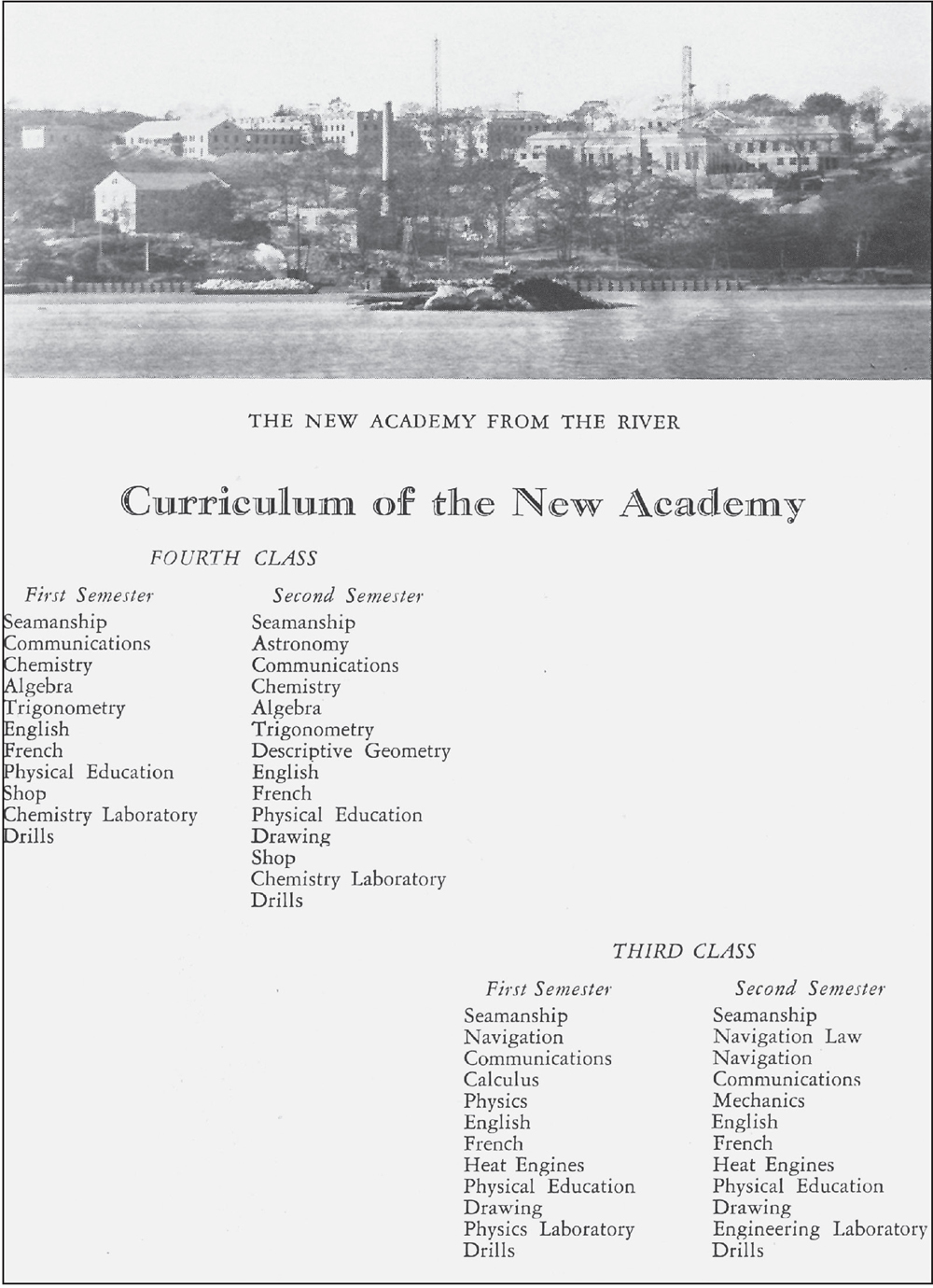
CURRICULUM OF THE ACADEMY, 1933. The classes for this year were similar to those taken by the class of 1963 in its first year, 1959. They included chemistry, algebra, trigonometry, English composition, communication, practical seamanship, graphics, analytical geometry, calculus, basic machines, and physical education. (1933 Tide Rips.)
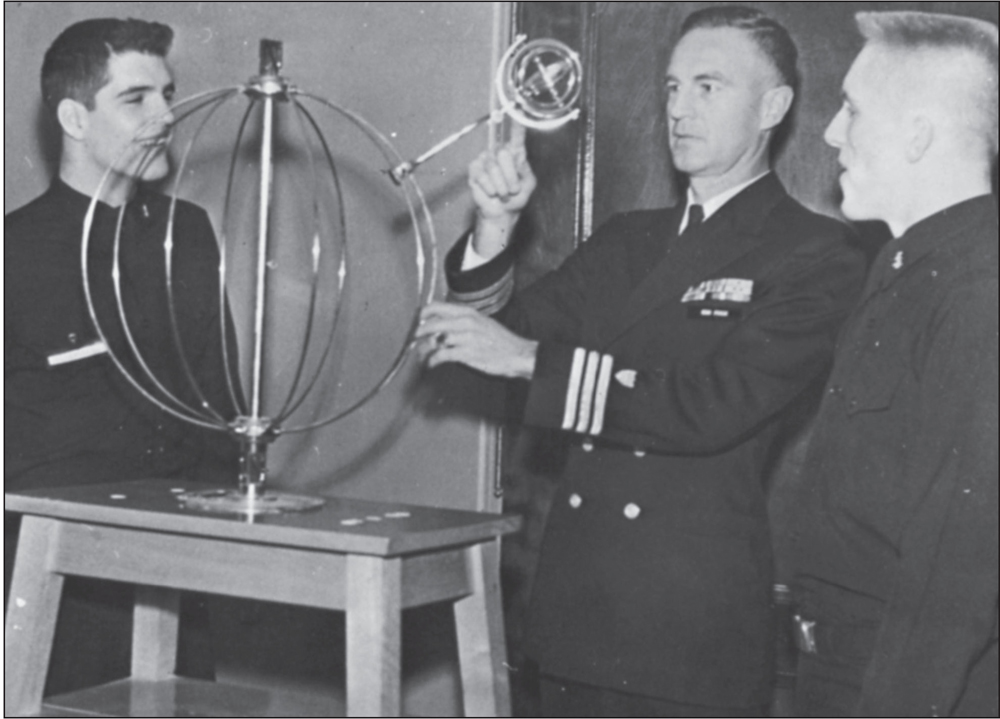
PHYSICS CLASS. In this picture, professor Cdr. Rod White (center; class of 1950) is teaching cadets third class Dave Zwick (left; class of 1963) and Dana Starkweather (class of 1963) about physics. Other courses taken in the third-class year included analytical geometry, calculus, modern world history, seamanship, navigation, US foreign policy, meteorology, and physical education. (1959 Tide Rips.)
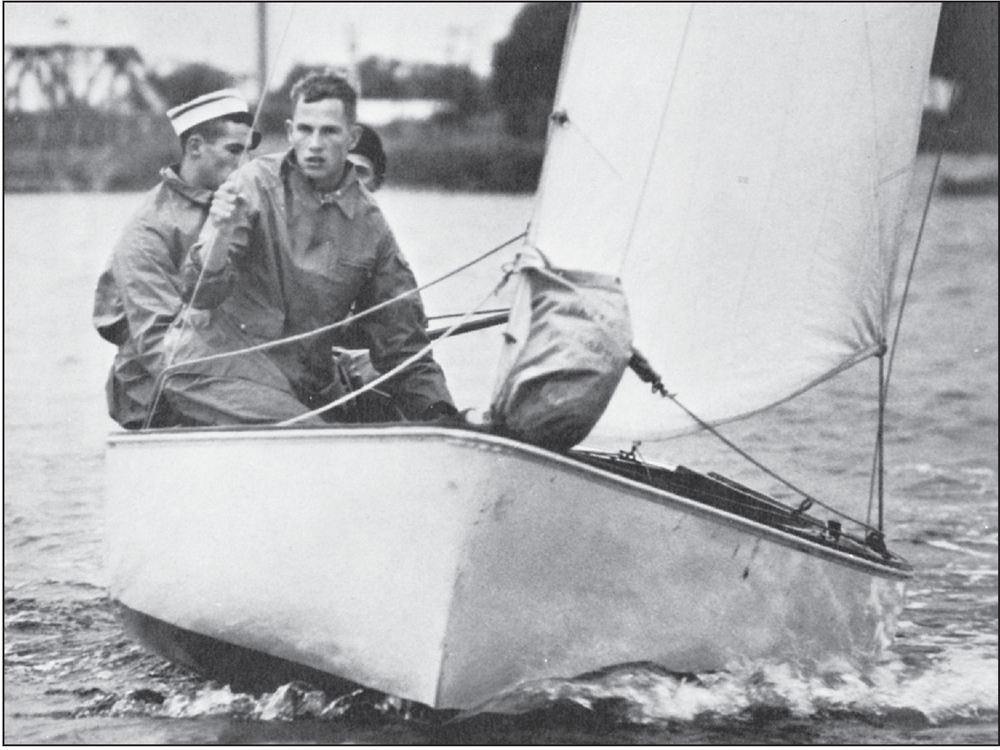
SAILING ON THE THAMES. The waterfront program is extensive, involving 120 vessels, and covers everything from basic seamanship and knot-tying to competitive sailing at the national level. The academy mission requires a liking for the sea and its lore. Academy graduates have a reputation of familiarity with the sea. (1967 Tide Rips.)
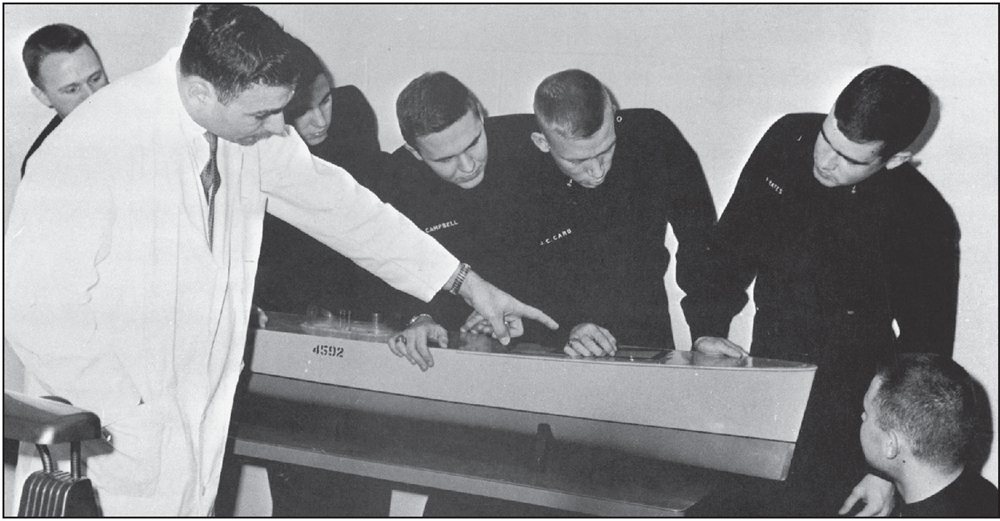
NAVAL ARCHITECTURE. Ship design is an important part of the academic program. For the class of 1963, this was the highest-weighted subject during the senior (or first-class) year. Oversight of the merchant marine industry and the safe operation of the nation’s ports require knowledge of ship design, construction, and operation. (1964 Tide Rips.)
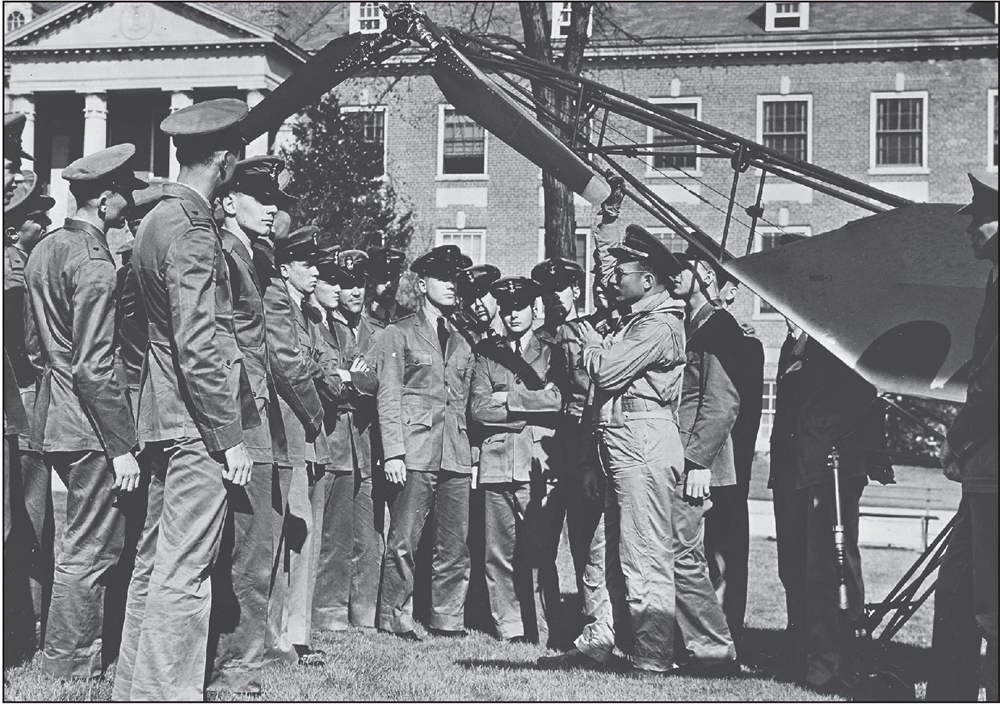
EARLY SIKORSKY HELICOPTER. This extremely basic helicopter was flown to the Washington Parade Ground from Floyd Bennett Field in Brooklyn. This would have been a flight requiring some daring given the distance and lack of navigational facilities. The pilot was the legendary “Stu” Graham. (1947 Tide Rips.)
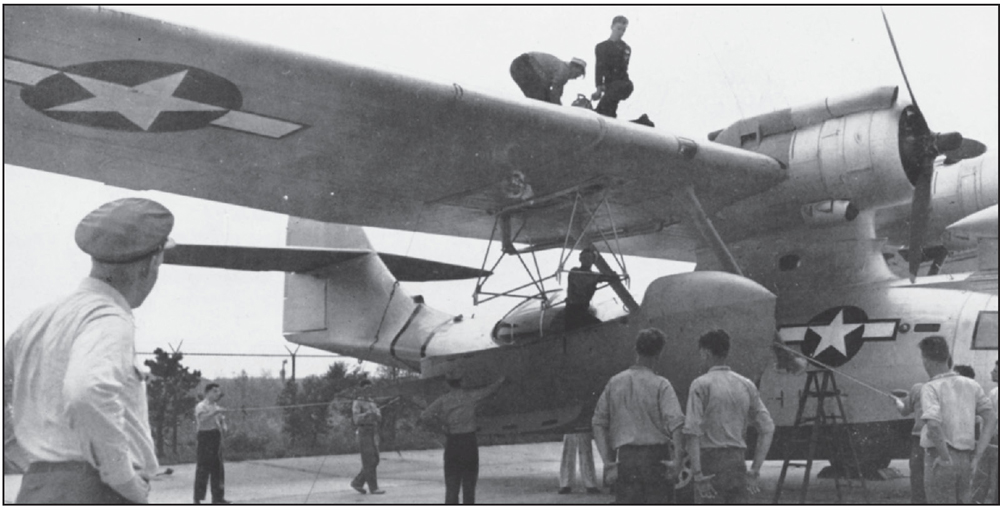
AVIATION INDOCTRINATION. Cadets spend time with a PBY aircraft at Elizabeth City Air Station in the 1940s. The aviation familiarity program has always been popular with cadets. In the case of the class of 1963, part of the training involved a flight from Elizabeth City, North Carolina, to Miami. (1948 Tide Rips.)
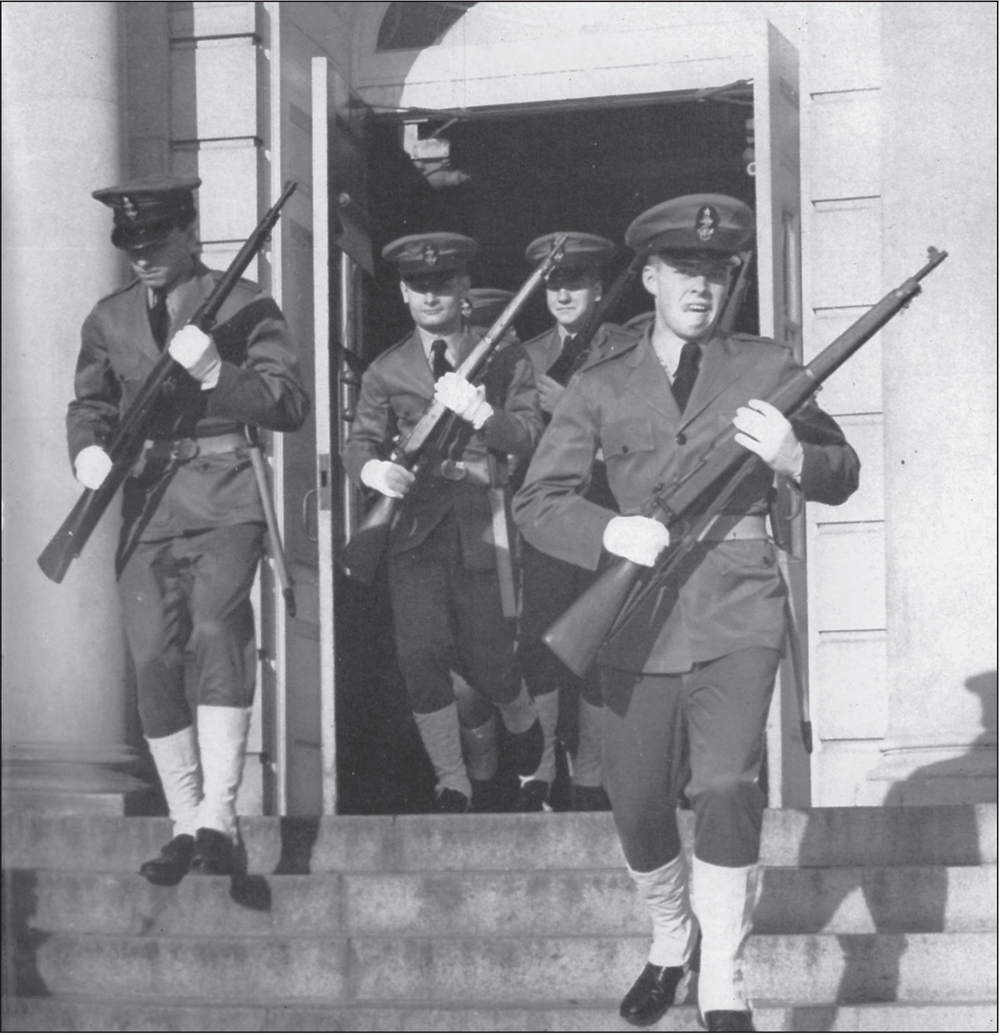
HEADING TO FORMATION. Cadets proceed to formation in wartime gray uniforms. The Coast Guard was the first service to wear the wartime gray uniform. World War II ushered in a major emphasis on the military program at the academy. These uniforms are no longer in use. (1942–1943 Tide Rips.)
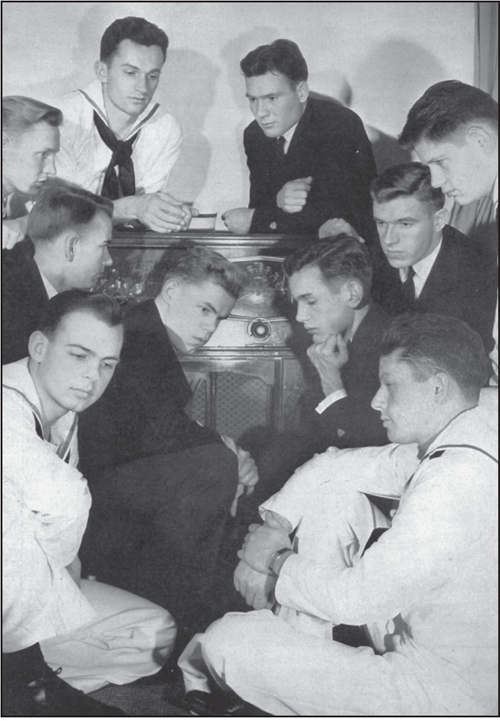
WAR IS DECLARED, DECEMBER 8, 1941. Cadets listen to Pres. Franklin D. Roosevelt’s “Day of Infamy” speech. The Coast Guard had been transferred into the Navy on November 1, 1941. These cadets knew that they were destined to see action upon graduation. (1942–1943 Tide Rips.)
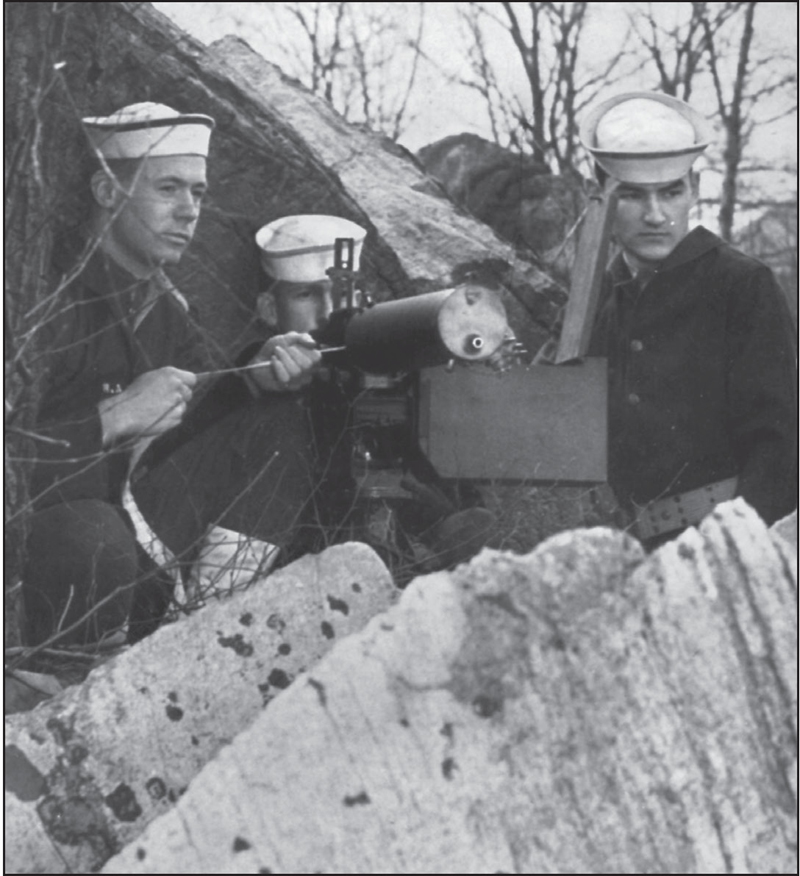
CADETS MAN A MACHINE GUN. The academy’s Charlie Company was responsible for machine guns and mortars. As World War II escalated, training at the academy was changed to include more defense-related items. The Coast Guard would participate in nearly every theater in the war. (1938 Tide Rips.)
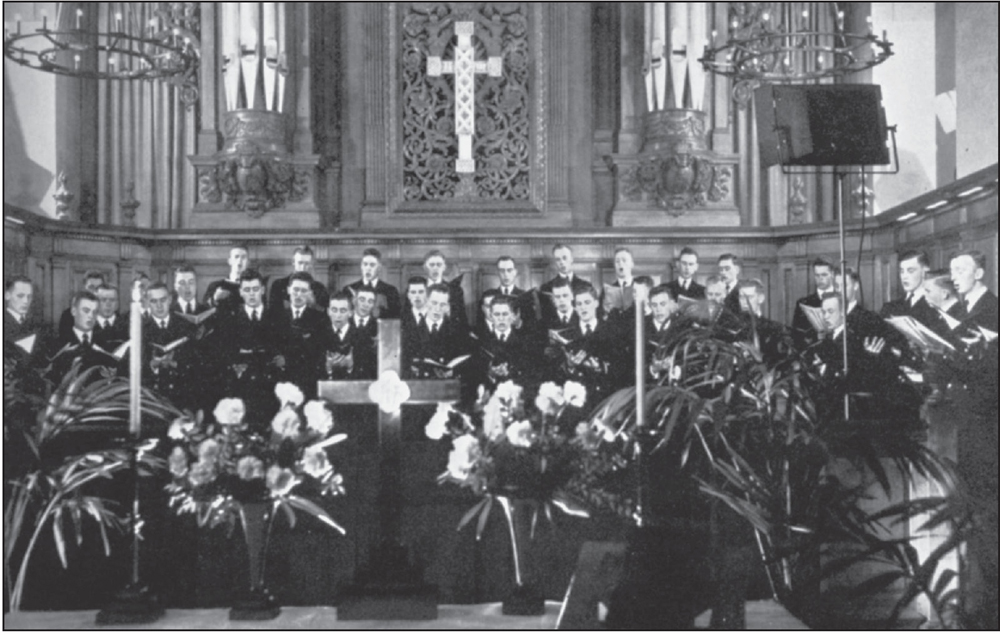
INSIDE THE CHAPEL. The religious program for the cadets centers around the US Coast Guard Memorial Chapel. There are both Protestant and Catholic choirs. The chapel is busy after graduation as cadets, who are forbidden to marry while they are at the academy, make up for lost time. (1950 Tide Rips.)
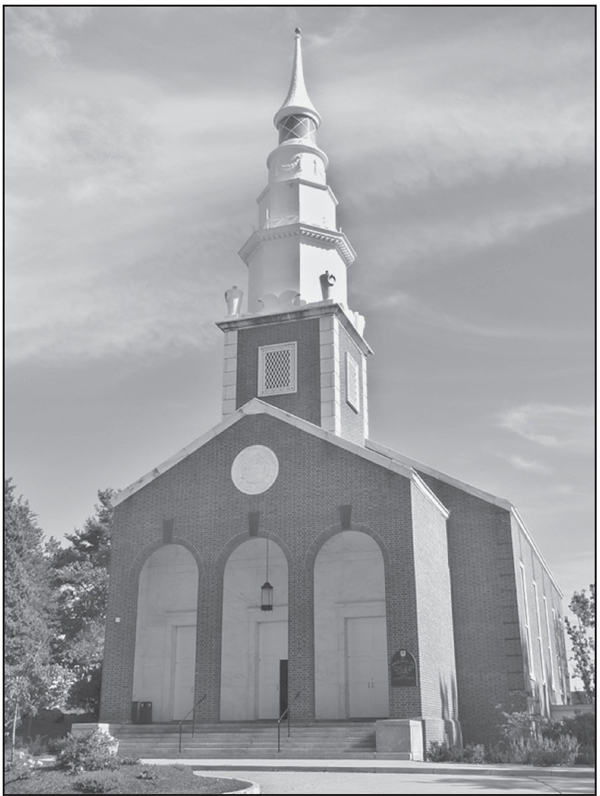
THE US COAST GUARD MEMORIAL CHAPEL. The chapel had been incorporated in the original plans for the academy, but the use of public funds to construct a chapel had caused much discussion. It was not until 1947 that Congress authorized the Coast Guard to build the chapel, but the funds needed to be raised through public subscription. A nationwide drive commenced. The largest contribution was $172,000 (from the A.W. Mellon Educational and Charitable Trust). Andrew W. Mellon was the secretary of the treasury from 1921 to 1932 and had always had a keen interest in the Coast Guard. (Author’s collection.)
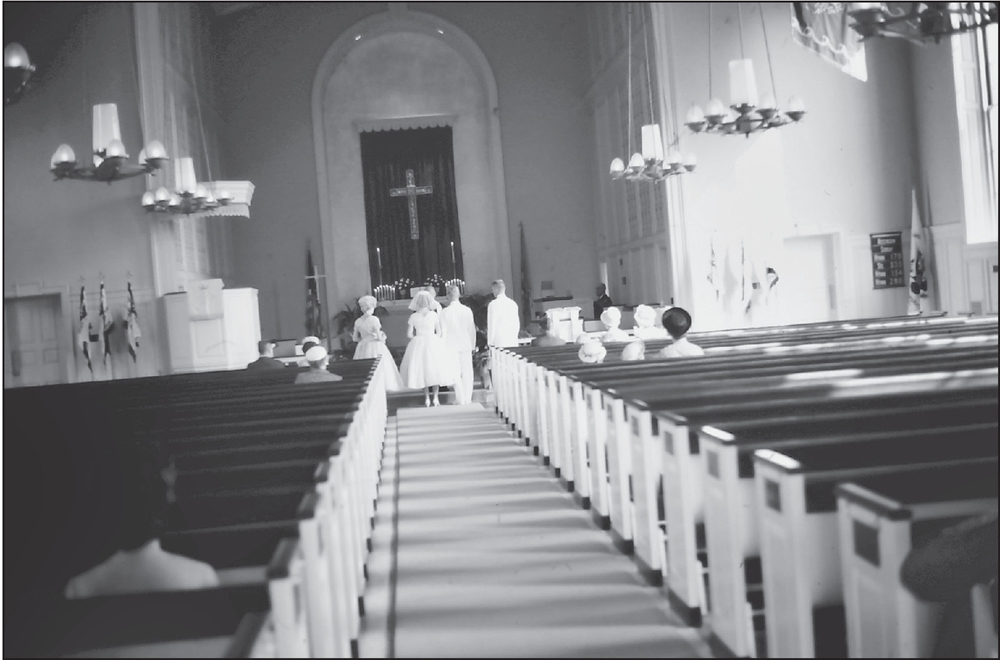
THE ACADEMY MEMORIAL CHAPEL INTERIOR. The pews provide seating for 480 and are made of solid mahogany and birch. The suspended lamps are designed in the motif of old whale-oil lamps. The organ is a three-manual digital electronic Renaissance model and was a gift from the class of 1950 given at the time of their 50th reunion. The lectern is dedicated to the 101 crew members of the USCGC Escanaba, which was lost at sea in World War II. (Author’s collection.)

ARCH OF SWORDS. A traditional military wedding requires six officers to form an arch of swords for the newlyweds. This was a windfall for those classmates who were not getting married, as they were invited to weddings across the country. The author went to six: Katz, a Jewish wedding at Idlewild Airport; Bluett in Baltimore; Heller in Grand Junction, Colorado; North in San Marino, California; Andrews in Long Beach; and Shorey in Pensacola, Florida. (1947 Tide Rips.)
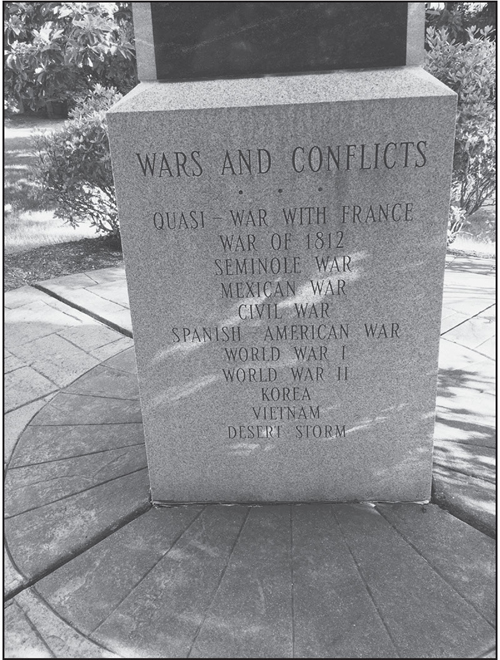
ENGRAVING ON THE WARS AND CONFLICTS MONUMENT. This monument is situated adjacent to the chapel in Robert Crown Park, which contains a number of historic and significant memorials. This black granite monument records all of the national conflicts in which the Coast Guard has participated. In the Quasi-War with France, the service was the only seagoing force, as the Navy had been disestablished. Pres. Barack Obama commented during his remarks at the 2015 graduation that he had seen Coast Guard personnel in the audience when he visited Afghanistan, which was a long way from the ocean. (Author’s collection.)
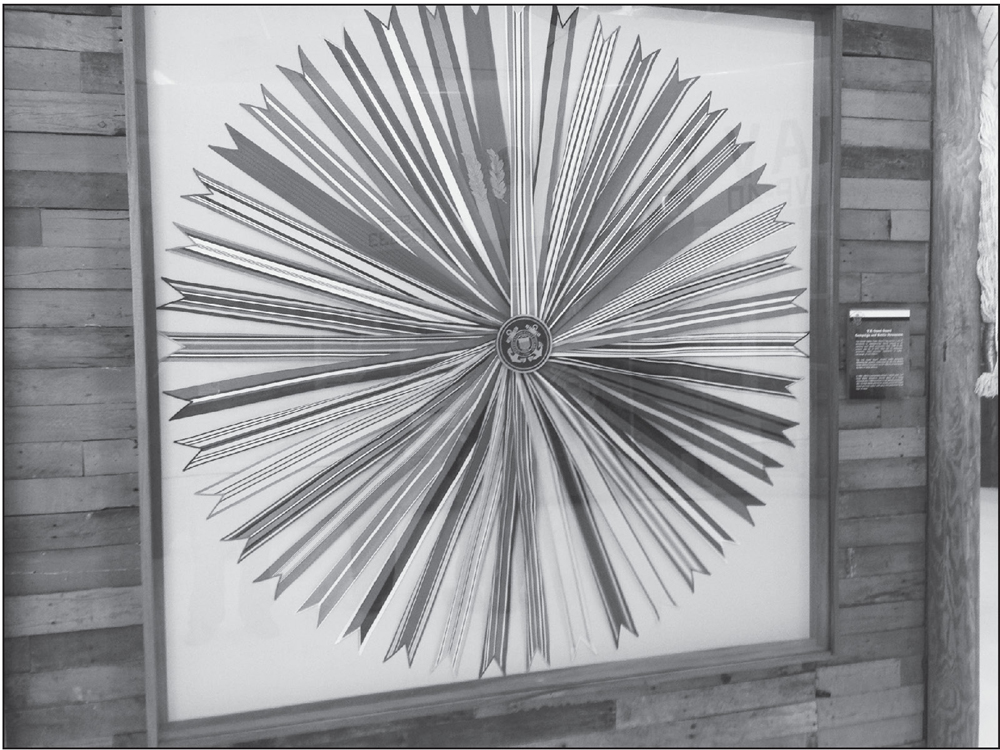
BATTLE STREAMERS OF THE COAST GUARD. Each streamer represents a battle or conflict in which the Coast Guard or Revenue Marine participated. This display is in the Coast Guard wing of the National Naval Aviation Museum in Pensacola, Florida. (Author’s collection.)

COLUMBARIUM. This is the only official Coast Guard burial site, which was dedicated on October 17, 2014. It is adjacent to the memorial chapel in the Robert Crown Park. The ashes of deceased service members and their wives can be placed here. The columbarium was built with donated funds. (Author’s collection.)
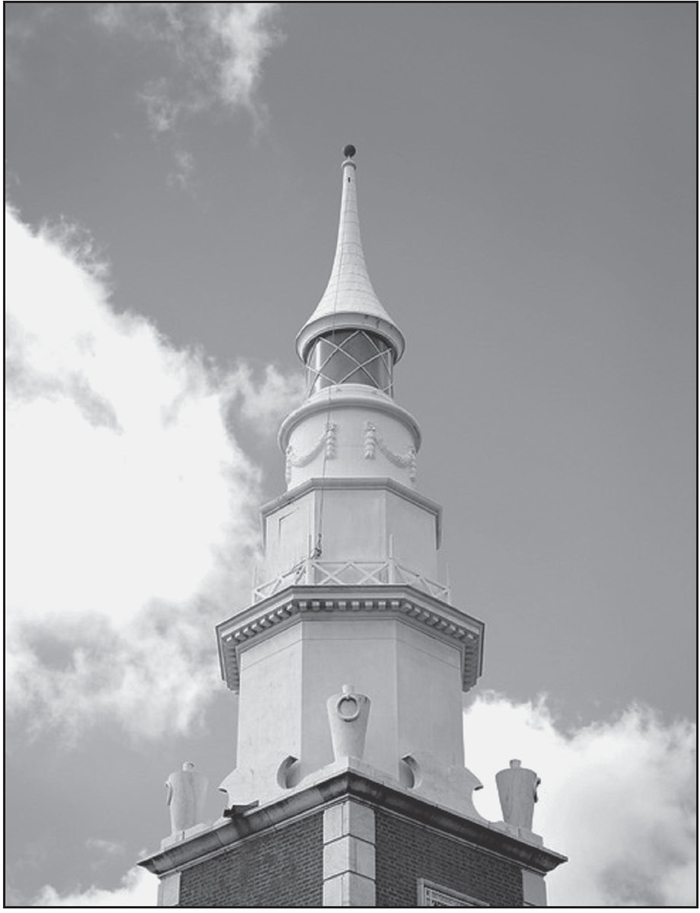
CHAPEL LIGHTHOUSE SPIRE. The chapel lantern is a typical pierhead tower lantern like those in common use on the Great Lakes. Below the light is the widow’s walk, added in memory of the wives of seafaring men who looked seaward in a vigil for their sailors coming home. This light can be seen from a great distance throughout the New London area. (Author’s collection.)
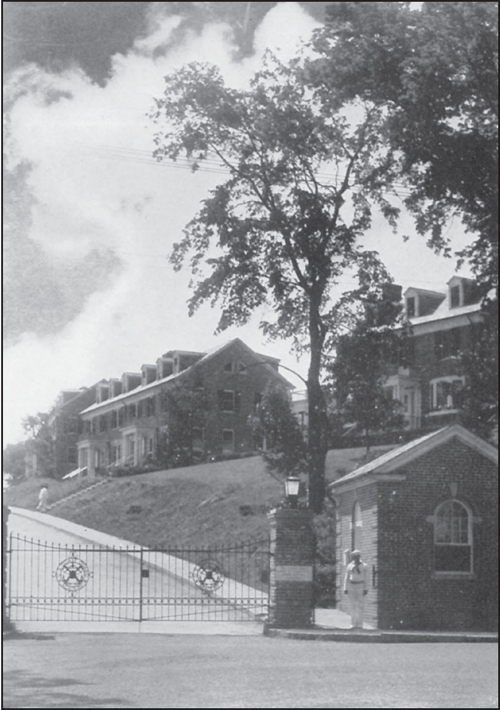
ORIGINAL POSITION OF THE MAIN GATE. This road leads up the hill toward the superintendent’s quarters and other senior staff quarters and ends at the chapel. The Robert Crown Park is behind the chapel. (1940 Tide Rips.)
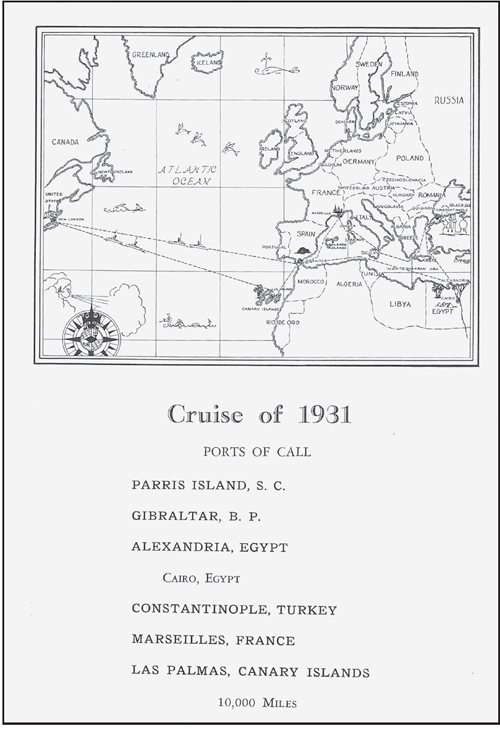
LONG CRUISE, 1931. The summer program’s long cruises are very popular and a unique part of the academy experience. This particular cruise covered 10,000 miles and included stops in Gibraltar, Egypt, Turkey, France, and the Canary Islands. In the early years, before the Revenue Cutter School of Instruction came ashore, these cruises could last for up to six months. (1932 Tide Rips.)
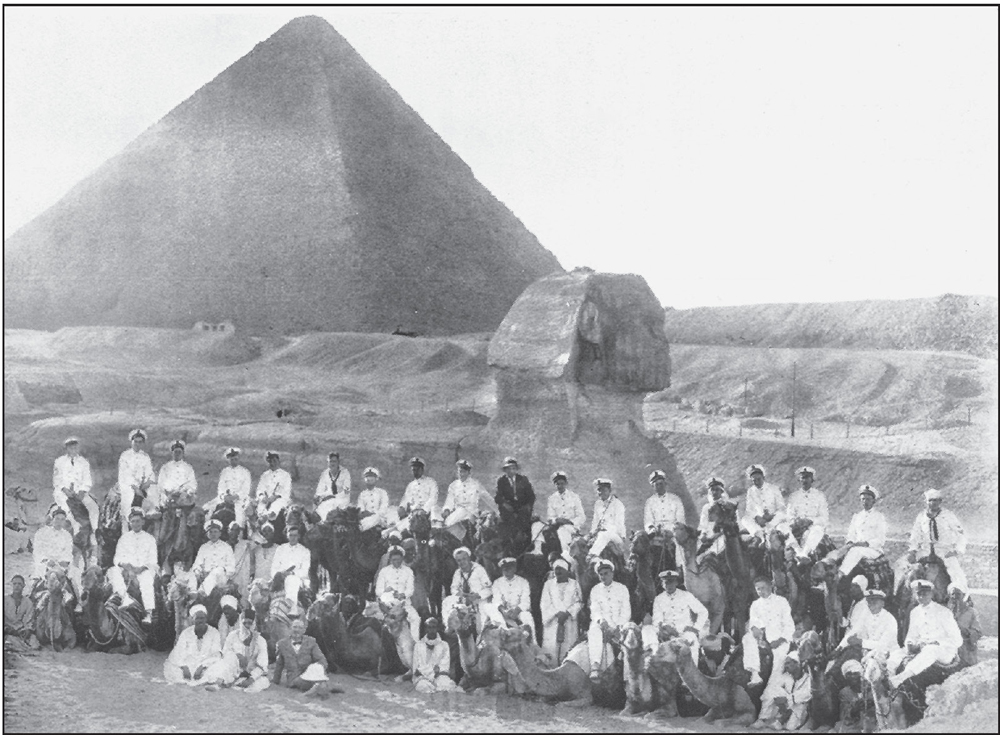
PICTURES FROM THE 1931 CRUISE. Some members of this group of cadets are sitting on camels with the iconic Egyptian pyramids in the background. The Sphinx is immediately behind the cadets. This famous structure with the body of a lion and head of a person is thought to have been built around 2494 BC. It was long believed that Napoleon’s artillery damaged the structure, but that claim has since been disputed. (1932 Tide Rips.)
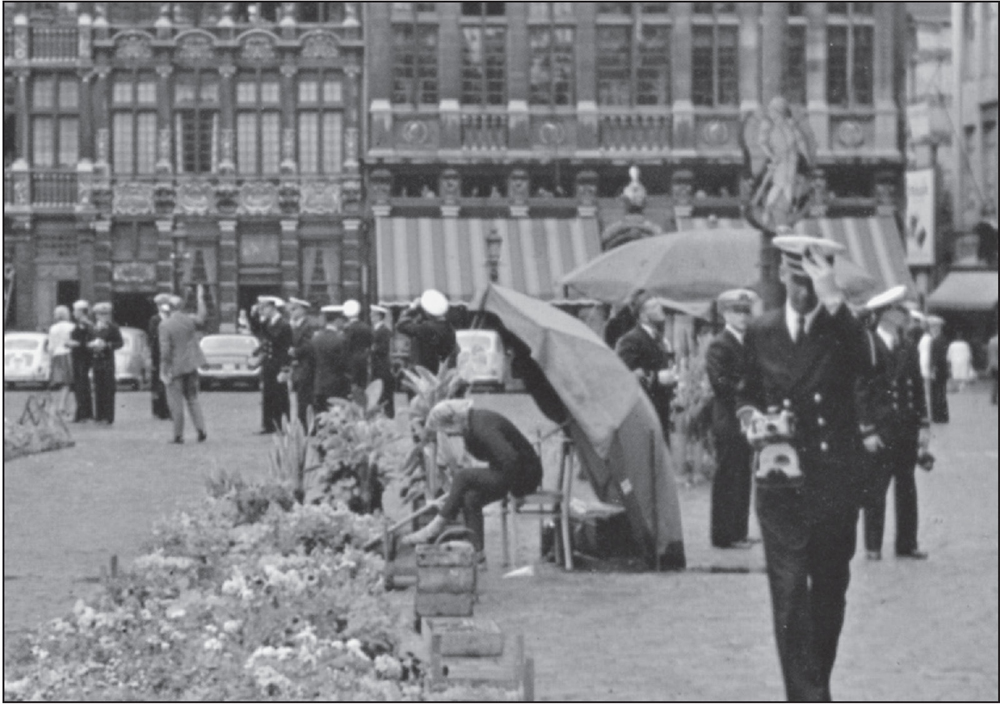
CRUISE TO BRUSSELS, 1960. These cadets are shown at an open-air market in Oslo, Norway. This was a particularly popular liberty stop. The beautiful Frogner Park, with its amazing statues, was impressive. The people were also quite welcoming. (Courtesy of Steve Ulmer.)
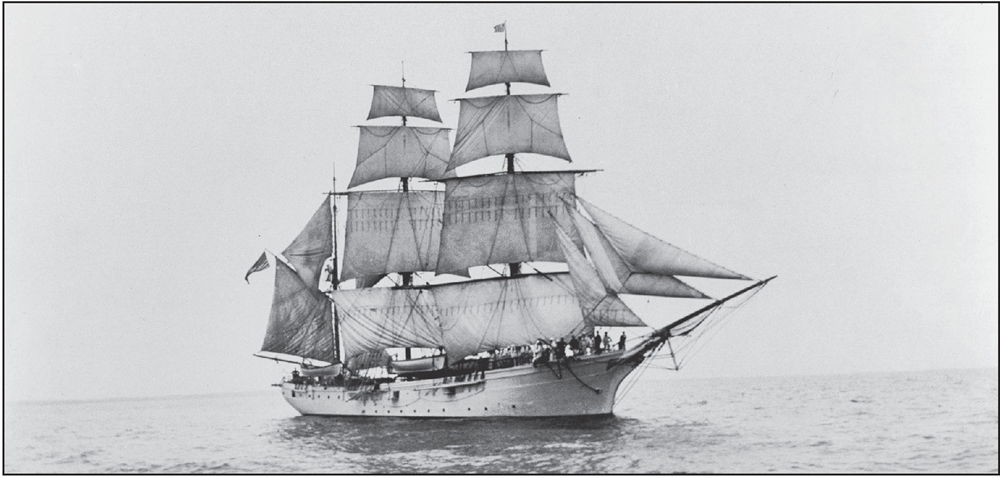
R/C SALMON P. CHASE. This was the primary training vessel for the academy from 1878 to 1907. She was a 115-foot barque-rigged clipper. The ship was named for Lincoln’s secretary of the treasury, Salmon P. Chase. She was homeported at the north end of Fish Island in New Bedford, Massachusetts, and later moved to Curtis Bay, Maryland. In 1895, the Chase was cut in two, and 40 feet were added to make more room for cadets. Most classes were small during this period, with numbers of graduates in the single digits. Ten graduated in 1896, one of whom was Harry Hamlet, who later served as superintendent and vice admiral. (Courtesy of US Coast Guard Commandant Public Relations.)

FOREWORD FROM THE 1939 TIDE RIPS. These sentiments—written nearly a century ago for the 25 graduates of the class of 1939—were relevant to the author’s class of 1963 and are still so today. The development of class spirit is evident in the high percentage of graduates who return for homecomings. (1939 Tide Rips.)
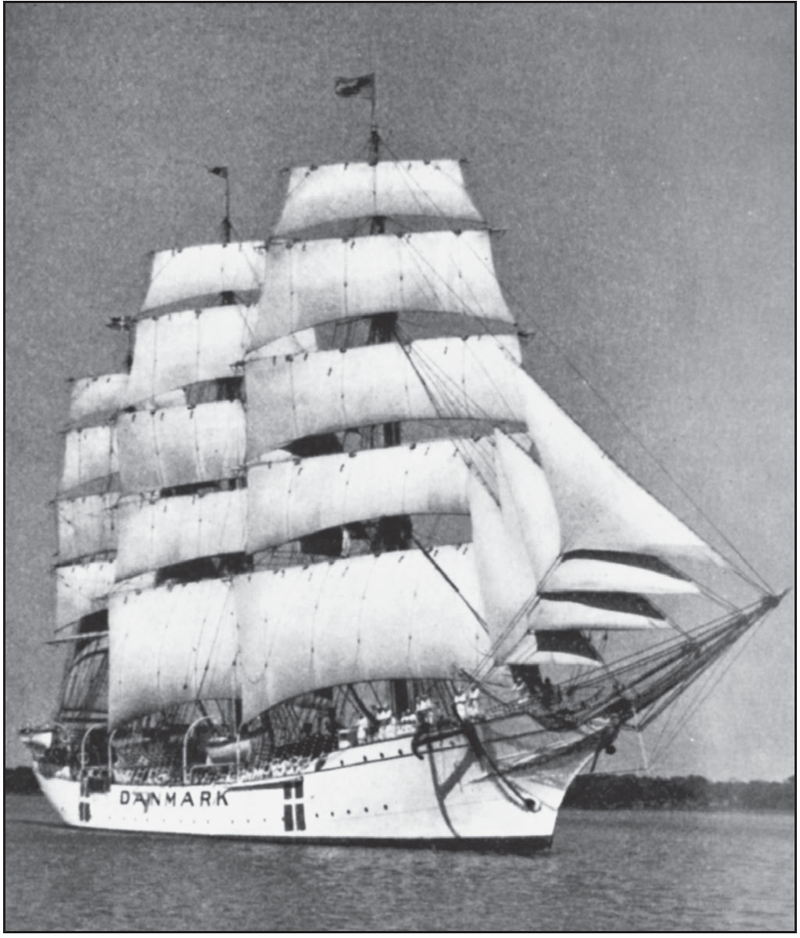
SAILING SHIP DANMARK. This Danish training vessel was in US waters when the Nazis overran Denmark. The captain placed his ship and crew at the disposal of the US government. The ship was built in 1933 and was 252 feet long. She was a full-rigged sailing ship and was used in the training of more than 3,000 cadets and reserve officer candidates during the war years from 1942 to 1945. The vessel returned home to Denmark and is still in use today. (Courtesy of US Coast Guard Commandant Public Relations.)
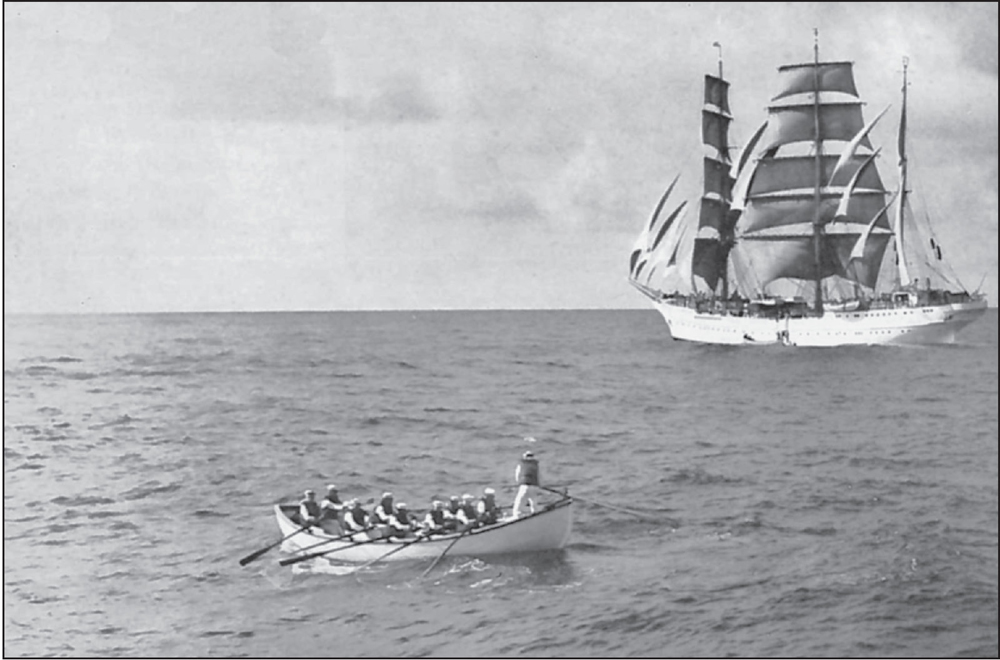
BOAT DRILLS ON A LONG CRUISE. Cadets spent an extensive number of days at sea during a long cruise. The cruise taken by the class of 1963 had a 21-day leg before it made its first port. (1955 Tide Rips.)
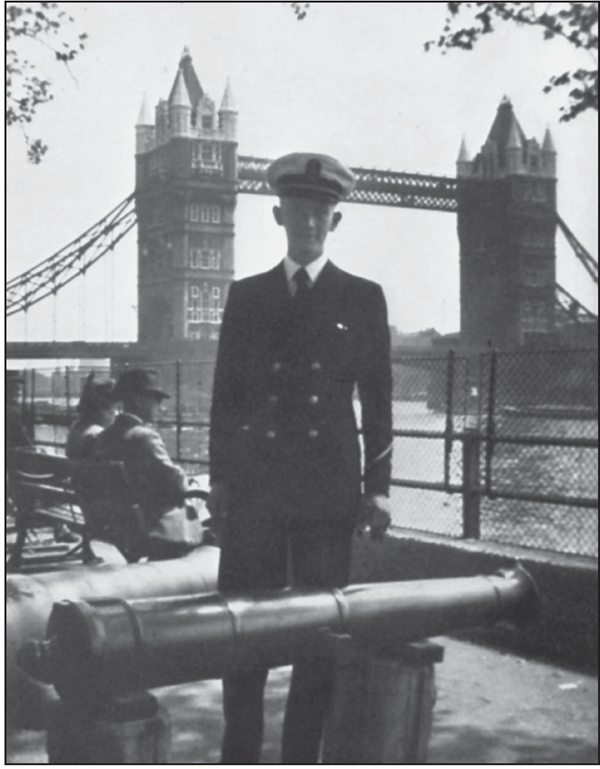
A CADET VISITING LONDON ON A LONG CRUISE. The class of 1963 had two long cruises. The first, in 1960, had liberty ports in Portsmouth, England; Oslo, Norway; and Le Havre, France. The first-class cruise in 1962 visited Edinburgh, Scotland; Antwerp, Belgium; and Las Palmas, in the Canary Islands. (1963 Tide Rips.)
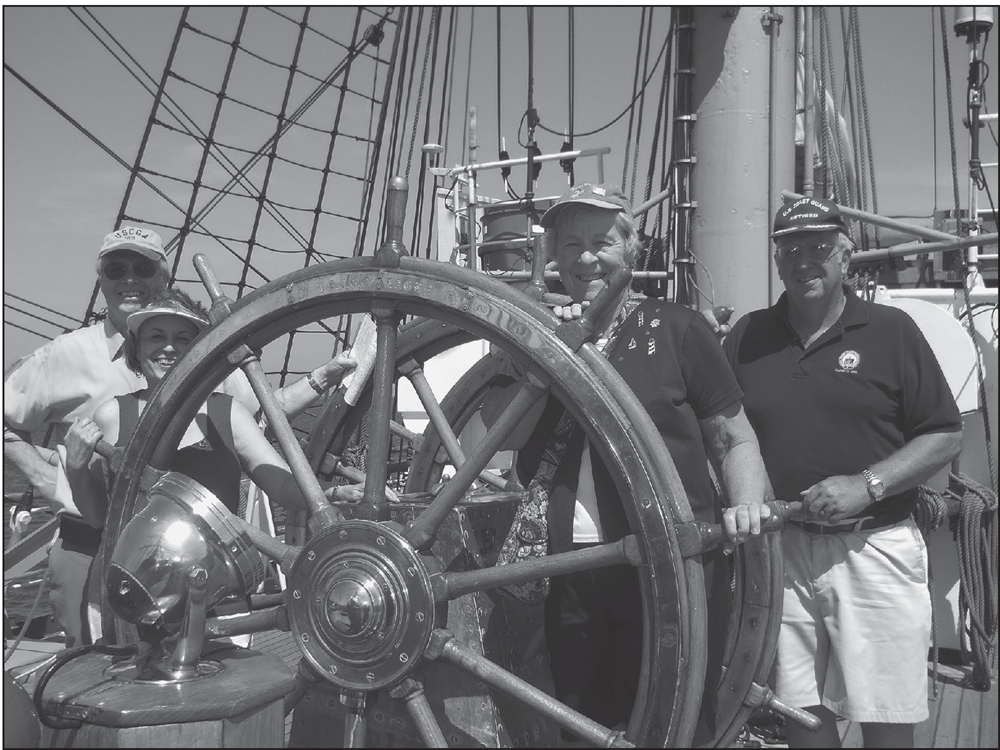
A VISIT TO THE EAGLE. Mike and Julie Burdian (left) and Jan and Jan Smith from the class of 1963 are shown visiting the Eagle. The ship is in beautiful condition, considering that at the time of the publication of this book, she was 84 years old. (Courtesy of Mike Burdian.)
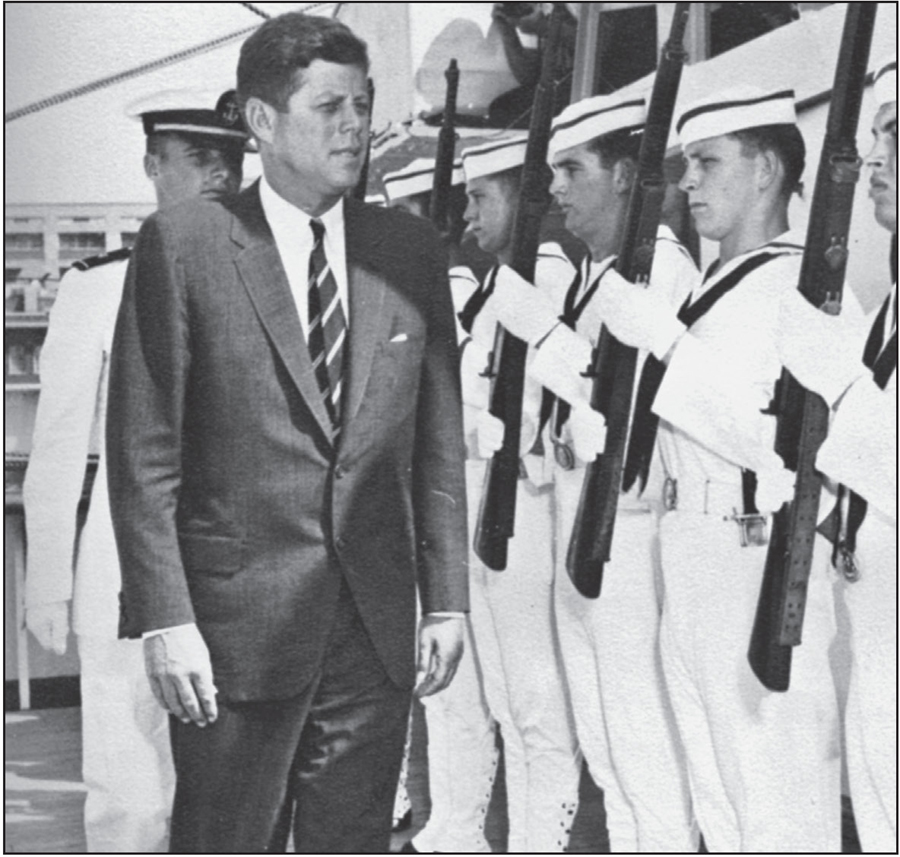
PRES. JOHN F. KENNEDY. The president made an official visit to the Eagle at the end of the 1962 long cruise. In charge of the honor guard is Cadet First Class Mike Burdian. Burdian had a successful 31-year career with IBM following his Coast Guard service. His son Steve (class of 1994) and daughter–in-law JoAnn (class of 1997) are both captains in the Coast Guard. (1963 Tide Rips.)
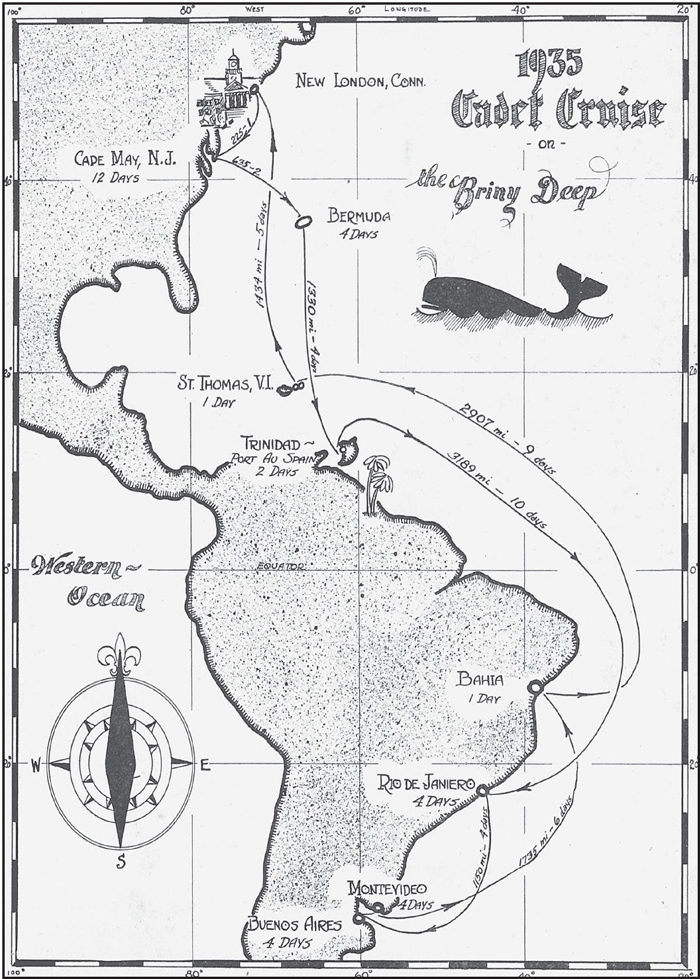
CHART OF 1935 LONG CRUISE. On this long cruise, port visits were made to Bermuda, Trinidad, Rio De Janeiro, Buenos Aires, Montevideo, Bahia, St. Thomas, and Cape May. There were 35 graduates in 1936, including future commandant Adm. Chester Bender, father of the modern single-breasted service uniform. (1936 Tide Rips.)
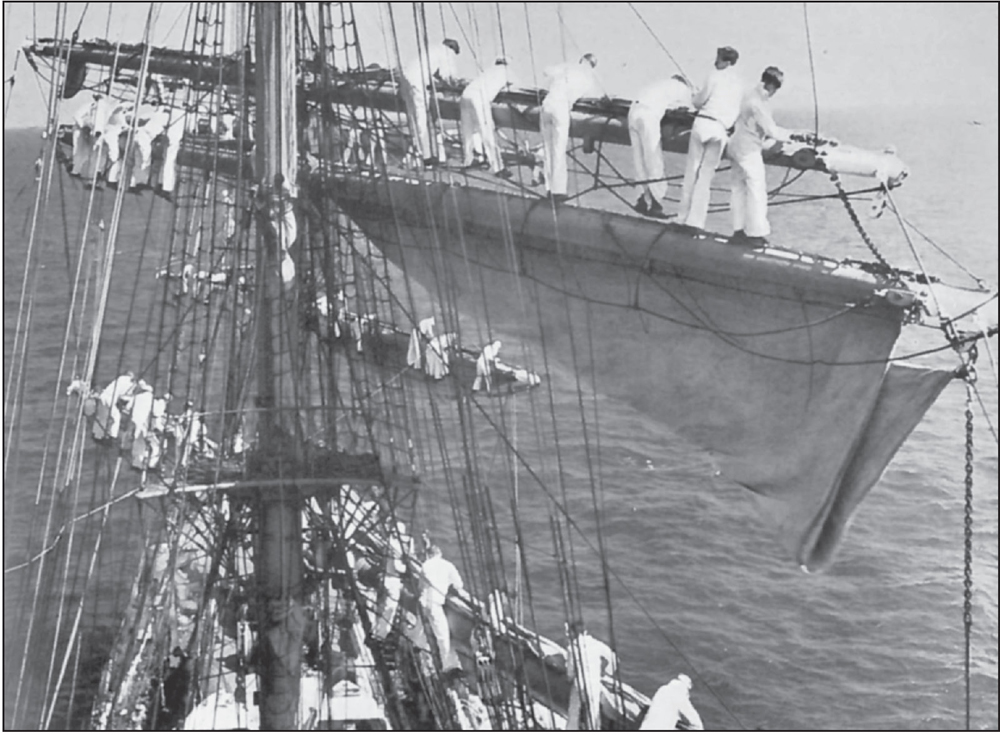
REEFING THE EAGLE’S SAILS. The cruises taught cadets the challenges of handling ships under sail. There are 145 different lines required to handle all of the Eagle’s sails. Third-class cadets were required to know the locations of them all. (1948 Tide Rips.)
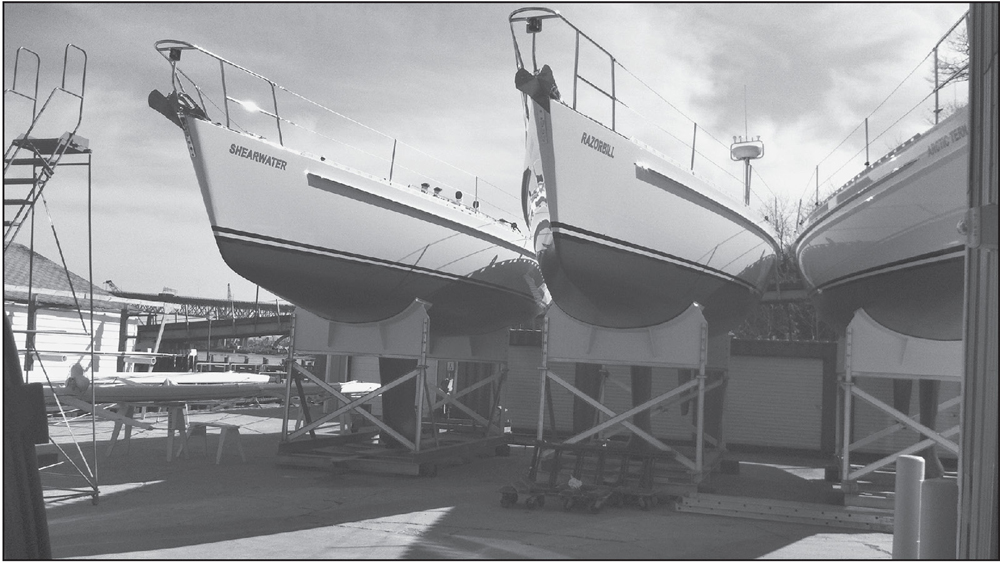
LEADERSHIP 44 YACHTS. One of the most popular programs is the Coastal Sail Training Program, which occurs during the second-class summer. The program entails six to eight cadets and an assigned safety officer conducting a two-week sailing event, during which the duties of cook, deckhand, navigator, and crew chief are rotated. (Author’s collection.)
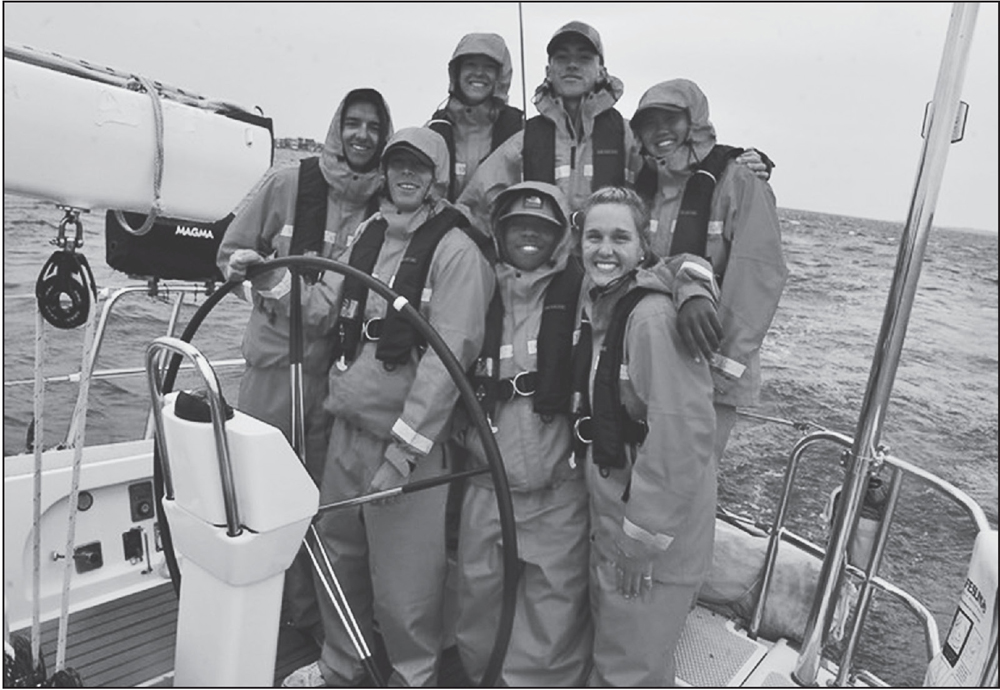
COASTAL SAIL TRAINING PROGRAM CREW. Members rotate through all the positions. The program teaches the fundamentals of coastal sailing and leadership and followership principles. (Courtesy of the US Coast Guard Academy; photograph by PO2 Jordan Park.)
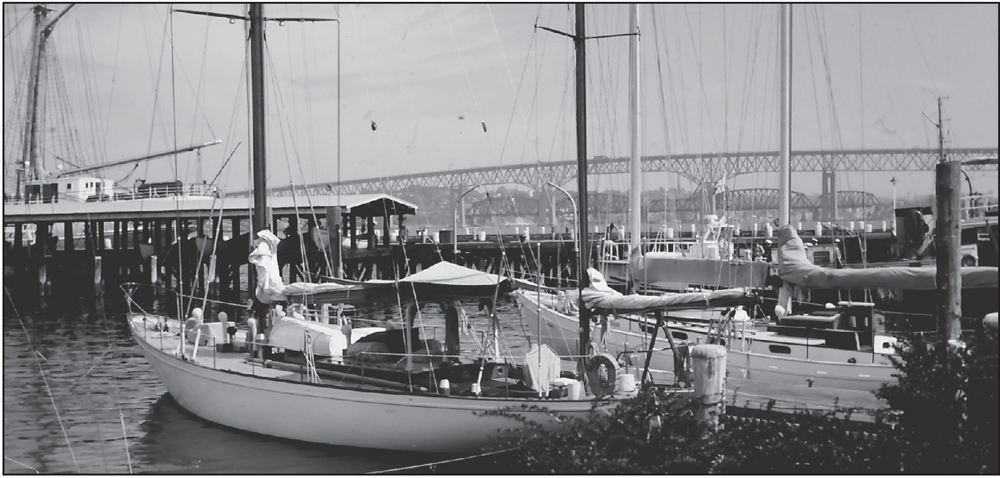
L44 YACHTS. Since the summer of 2013, the Coastal Sail Training Program has been done on eight yachts that were donated to the academy and cost approximately $1 million each. They are L44-01 Shearwater, sponsored by the class of 1953; L44-02 Arctic Tern, sponsored by the parents’ association; L44-03 Stormy Petrel, sponsored by the class of 1958; L44-04 Blue Goose, sponsored by the Coast Guard Foundation; L44-05 Osprey, sponsored by the class of 1966; L44-06 Seahawk, sponsored by the class of 1960; L44-07 Razorbill, sponsored by the Coast Guard Foundation; and L44-08 Egret, sponsored by the Coast Guard Foundation. (Author’s collection.)
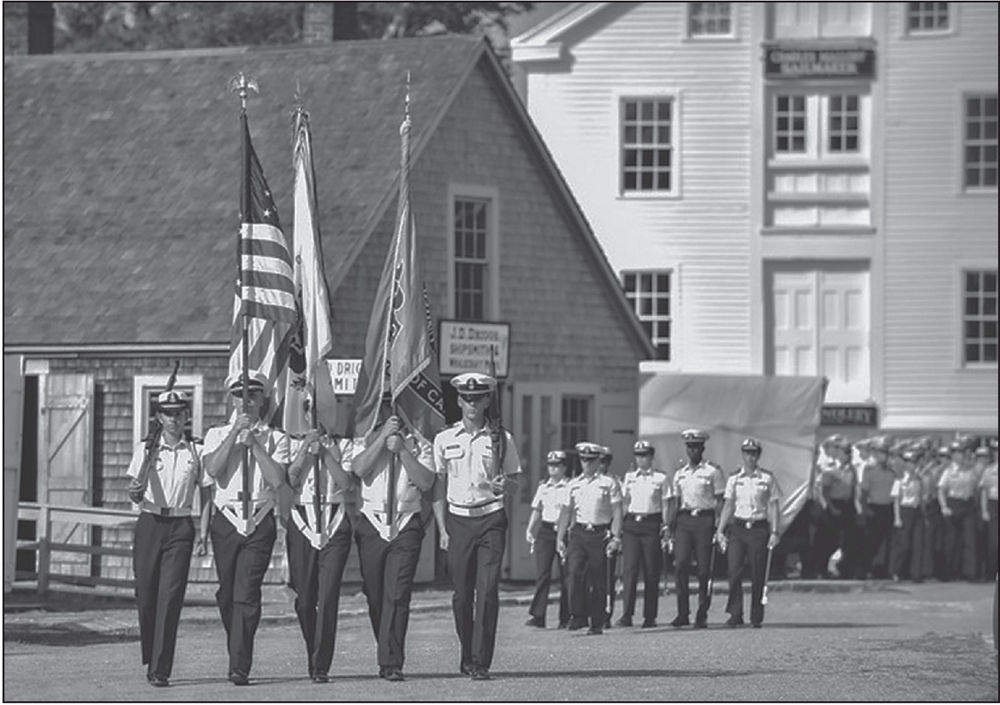
MYSTIC FLAG DAY. One of the first events in which the new cadets are permitted to visit outside the academy campus is the Mystic Seaport Flag Day. This was the first liberty the author’s class had in 1959, although they did not call it Flag Day then. The Mystic Seaport demonstrates the seafaring history of the New London area. In a recent addition, the incoming class has its flag dedicated each year. (Courtesy of the US Coast Guard Academy; photograph by PO3 Mathew Thieme.)
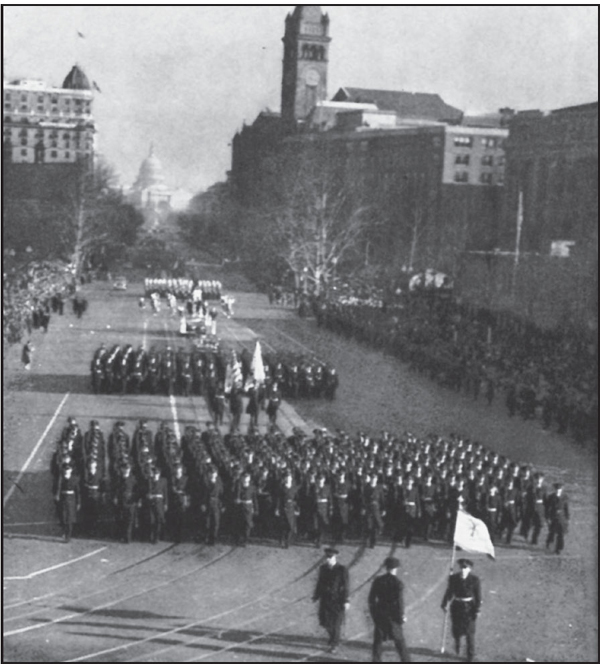
MARCHING IN PRES. DWIGHT D. EISENHOWER’S INAUGURATION. Every four years, the Academy Corps is transported to Washington, DC, to march in the inauguration. There is a lot of practice beforehand to ensure the military precision deserving of the event. The class of 1963 was honored to march in John F. Kennedy’s inauguration in 1961. There was snow on the ground, and the cadets very nearly froze their feet in their low-cut dress oxfords. (1950 Tide Rips.)

PARADE IN NEW LONDON. The academy has been in the New London, Connecticut, area since 1910, when it moved to Fort Trumbull. Located midway between Boston and New York City, New London offers close proximity to large metro areas in an place with a rich seagoing history that makes for a nice fit. The community has been welcoming to the academy, including giving it a favorable price for its current location. (1954 Tide Rips.)
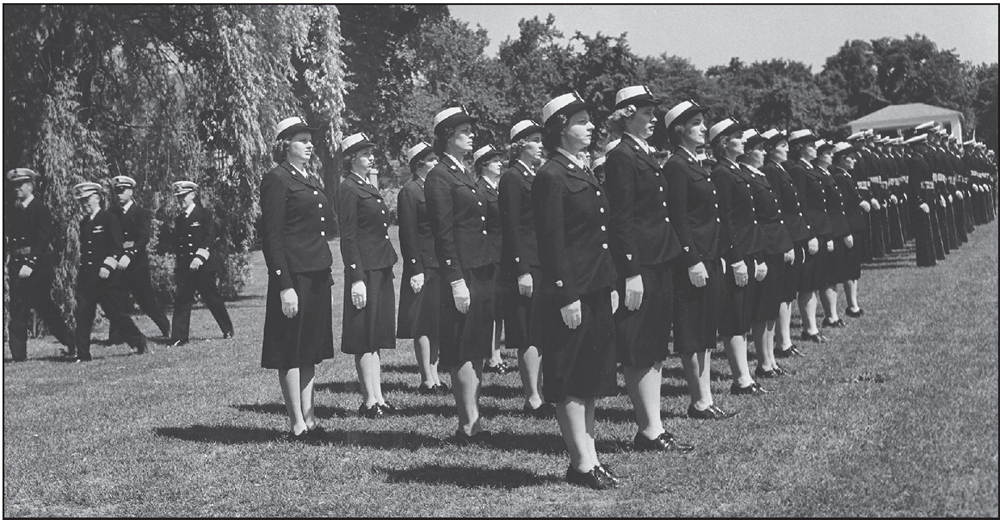
SPARS AT THE ACADEMY. On June 28, 1943, the first women became part of the academy when 50 officer candidates, the Coast Guard Women’s Reserve, reported for indoctrination. However, they were only there for a streamlined six-week program—women did not actually become part of the regular academy until 1976. The name “SPARS” came from the first letters of the Coast Guard motto: “Semper Paratus, Always Ready.” The Coast Guard Women’s Reserve was established by Congress and signed into law by Pres. Franklin D. Roosevelt on November 23, 1942. (1944 Tide Rips.)
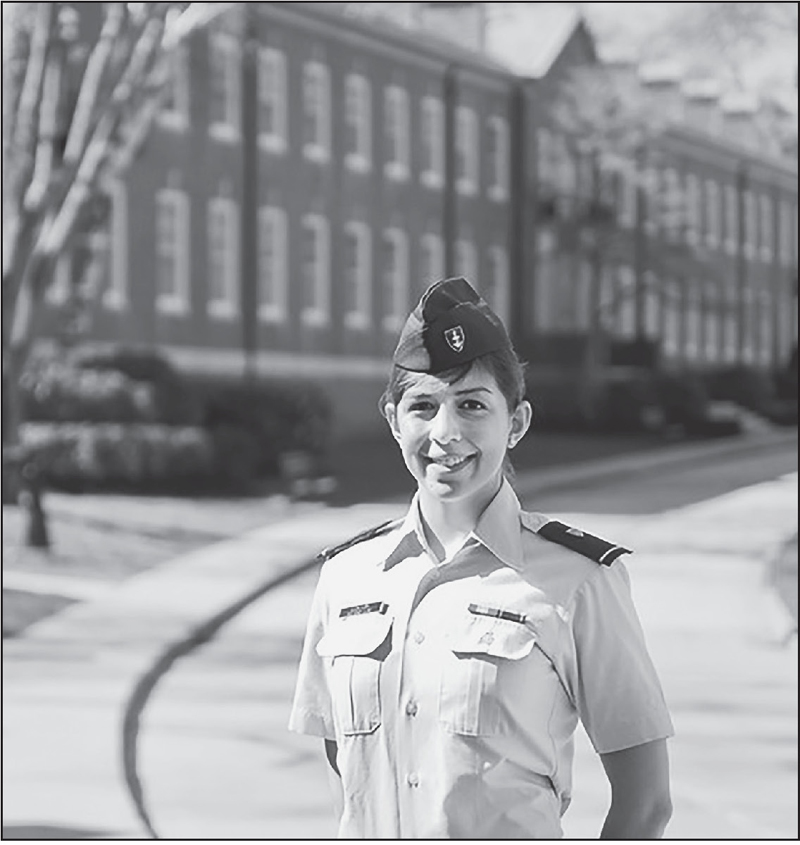
CADET FIRST CLASS JESSICA LUKASIK. In 2014, Lukasik was selected for the prestigious Fulbright Scholarship to study the fisheries and tourism industry on Mauritius, a small island nation some 1,200 miles off the coast of Africa. She would be studying at the University of Mauritius. The alumni association assists with funding for these important scholarships. (Courtesy of the US Coast Guard Academy; photograph by PO2 Cory Mendenhall.)
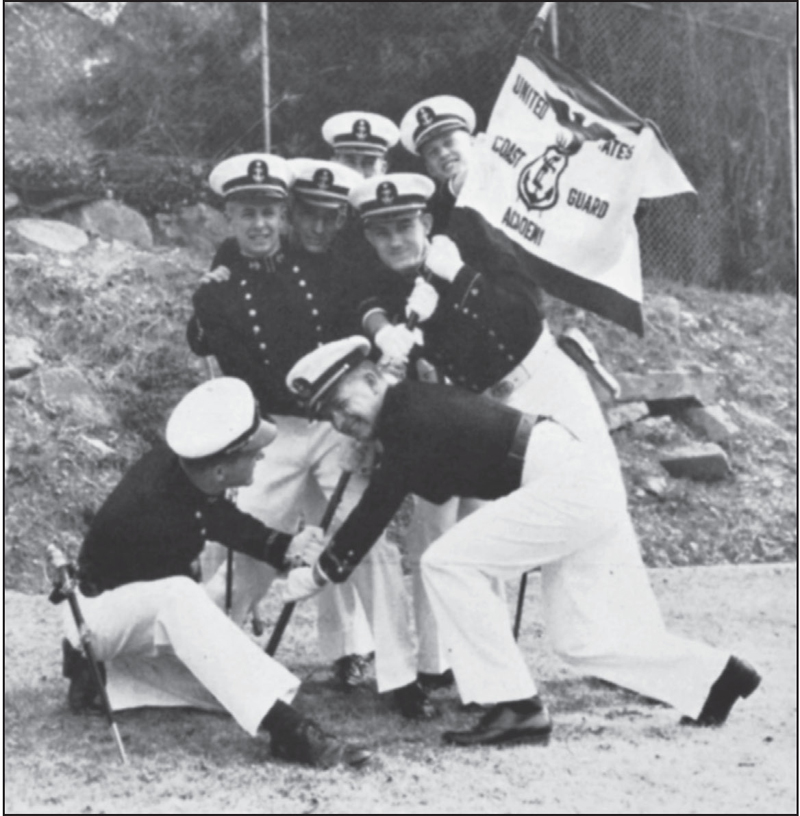
GUIDONS. Military formations continue from First Day to the Graduation Review. The guidons shown here in a lighter moment are used to line up the companies into regimental formations. (1952 Tide Rips.)
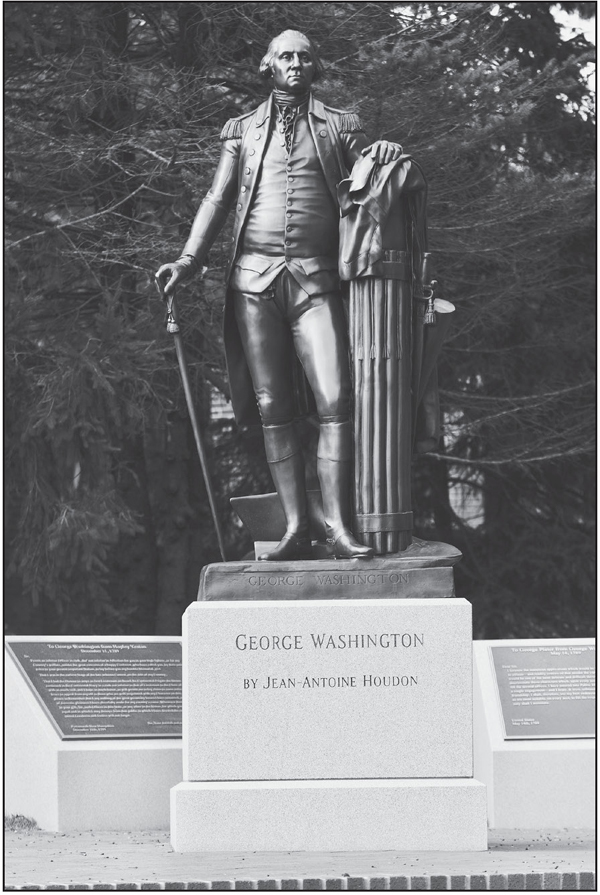
GEORGE WASHINGTON MONUMENT. This monument watches over the Washington Parade Ground. This statue is a bronze reproduction of the original statue of Washington created by French sculptor Jean-Antoine Houdon in 1792. The monument was dedicated by the class of 1969 on the occasion of their 50th homecoming. (Courtesy of Paul Duddy.)
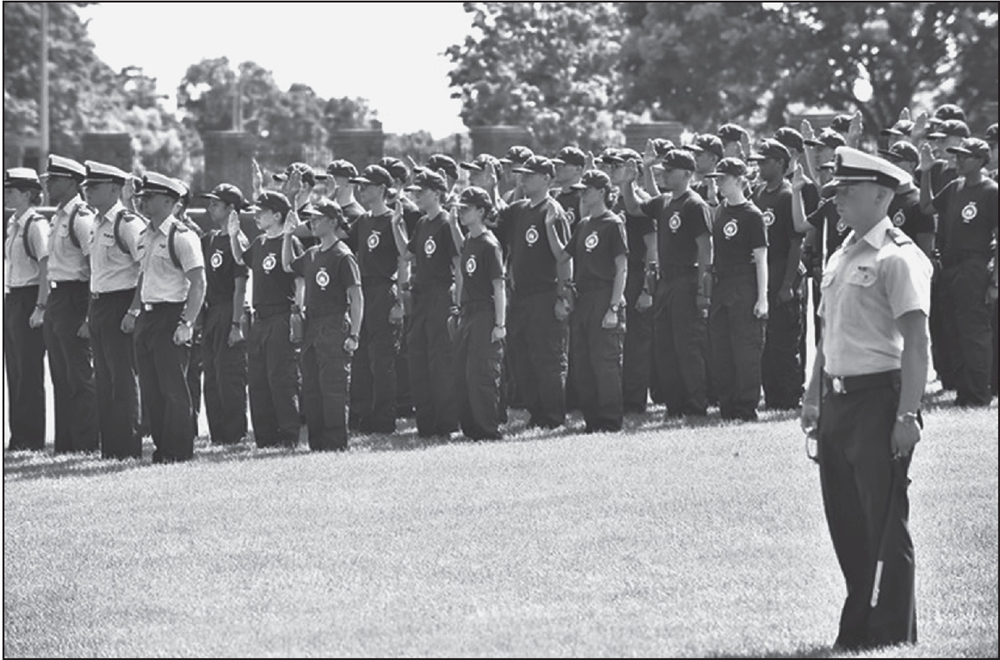
WASHINGTON PARADE GROUND. The class of 2023 is pictured on July 1, 2019—their Swearing-In Day (or Day 1). This is the first day of Swab Summer, an exciting and intense seven-week training period that forms the foundation of each cadet’s academy experience and military career. For parents, Swearing-In Day is a time to say goodbye and to let their son or daughter know that this is the beginning of a great adventure. (Courtesy of Paul Duddy.)








































